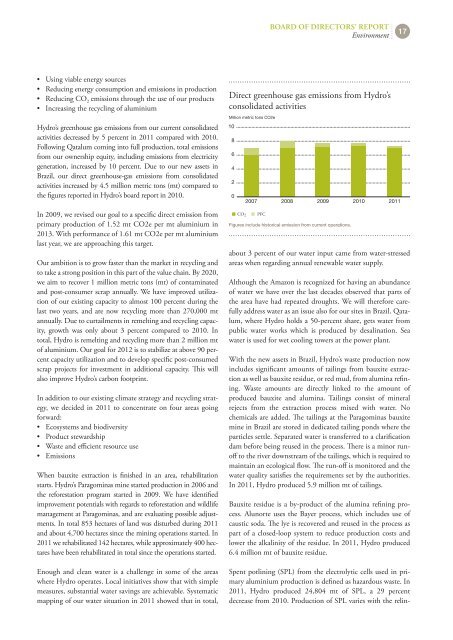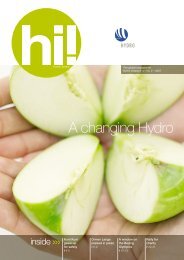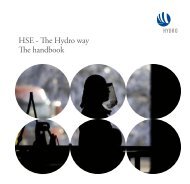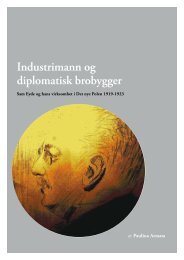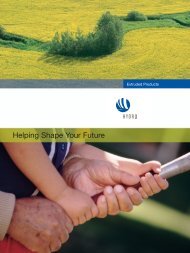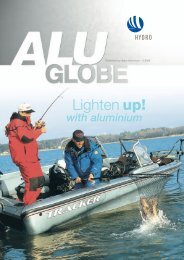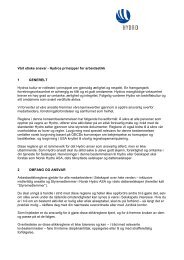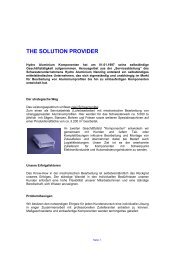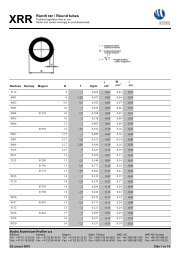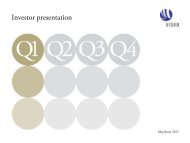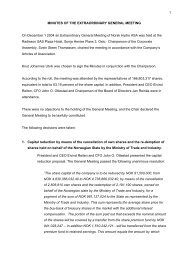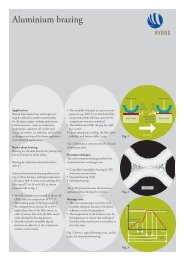Hydro Annual Report 2011b
Hydro Annual Report 2011b
Hydro Annual Report 2011b
Create successful ePaper yourself
Turn your PDF publications into a flip-book with our unique Google optimized e-Paper software.
• Using viable energy sources<br />
• Reducing energy consumption and emissions in production<br />
• Reducing CO 2 emissions through the use of our products<br />
• Increasing the recycling of aluminium<br />
<strong>Hydro</strong>’s greenhouse gas emissions from our current consolidated<br />
activities decreased by 5 percent in 2011 compared with 2010.<br />
following Qatalum coming into full production, total emissions<br />
from our ownership equity, including emissions from electricity<br />
generation, increased by 10 percent. Due to our new assets in<br />
Brazil, our direct greenhouse-gas emissions from consolidated<br />
activities increased by 4.5 million metric tons (mt) compared to<br />
the figures reported in <strong>Hydro</strong>’s board report in 2010.<br />
In 2009, we revised our goal to a specific direct emission from<br />
primary production of 1.52 mt CO2e per mt aluminium in<br />
2013. With performance of 1.61 mt CO2e per mt aluminium<br />
last year, we are approaching this target.<br />
Our ambition is to grow faster than the market in recycling and<br />
to take a strong position in this part of the value chain. By 2020,<br />
we aim to recover 1 million metric tons (mt) of contaminated<br />
and post-consumer scrap annually. We have improved utilization<br />
of our existing capacity to almost 100 percent during the<br />
last two years, and are now recycling more than 270,000 mt<br />
annually. Due to curtailments in remelting and recycling capacity,<br />
growth was only about 3 percent compared to 2010. In<br />
total, <strong>Hydro</strong> is remelting and recycling more than 2 million mt<br />
of aluminium. Our goal for 2012 is to stabilize at above 90 percent<br />
capacity utilization and to develop specific post-consumed<br />
scrap projects for investment in additional capacity. This will<br />
also improve <strong>Hydro</strong>’s carbon footprint.<br />
In addition to our existing climate strategy and recycling strategy,<br />
we decided in 2011 to concentrate on four areas going<br />
forward:<br />
• Ecosystems and biodiversity<br />
• Product stewardship<br />
• Waste and efficient resource use<br />
• Emissions<br />
When bauxite extraction is finished in an area, rehabilitation<br />
starts. <strong>Hydro</strong>’s Paragominas mine started production in 2006 and<br />
the reforestation program started in 2009. We have identified<br />
improvement potentials with regards to reforestation and wildlife<br />
management at Paragominas, and are evaluating possible adjustments.<br />
In total 853 hectares of land was disturbed during 2011<br />
and about 4,700 hectares since the mining operations started. In<br />
2011 we rehabilitated 142 hectares, while approximately 400 hectares<br />
have been rehabilitated in total since the operations started.<br />
Enough and clean water is a challenge in some of the areas<br />
where <strong>Hydro</strong> operates. Local initiatives show that with simple<br />
measures, substantial water savings are achievable. Systematic<br />
mapping of our water situation in 2011 showed that in total,<br />
BoArD oF DIreCtors’ report<br />
Environment<br />
Direct greenhouse gas emissions from <strong>Hydro</strong>’s<br />
consolidated activities<br />
Million metric tons CO2e<br />
10<br />
8<br />
6<br />
4<br />
2<br />
0<br />
CO2<br />
2007<br />
PFC<br />
2008<br />
2009<br />
Figures include historical emission from current operations.<br />
2010<br />
2011<br />
17<br />
about 3 percent of our water input came from water-stressed<br />
areas when regarding annual renewable water supply.<br />
Although the Amazon is recognized for having an abundance<br />
of water we have over the last decades observed that parts of<br />
the area have had repeated droughts. We will therefore carefully<br />
address water as an issue also for our sites in Brazil. Qatalum,<br />
where <strong>Hydro</strong> holds a 50-percent share, gets water from<br />
public water works which is produced by desalination. Sea<br />
water is used for wet cooling towers at the power plant.<br />
With the new assets in Brazil, <strong>Hydro</strong>’s waste production now<br />
includes significant amounts of tailings from bauxite extraction<br />
as well as bauxite residue, or red mud, from alumina refining.<br />
Waste amounts are directly linked to the amount of<br />
produced bauxite and alumina. Tailings consist of mineral<br />
rejects from the extraction process mixed with water. No<br />
chemicals are added. The tailings at the Paragominas bauxite<br />
mine in Brazil are stored in dedicated tailing ponds where the<br />
particles settle. Separated water is transferred to a clarification<br />
dam before being reused in the process. There is a minor runoff<br />
to the river downstream of the tailings, which is required to<br />
maintain an ecological flow. The run-off is monitored and the<br />
water quality satisfies the requirements set by the authorities.<br />
In 2011, <strong>Hydro</strong> produced 5.9 million mt of tailings.<br />
Bauxite residue is a by-product of the alumina refining process.<br />
Alunorte uses the Bayer process, which includes use of<br />
caustic soda. The lye is recovered and reused in the process as<br />
part of a closed-loop system to reduce production costs and<br />
lower the alkalinity of the residue. In 2011, <strong>Hydro</strong> produced<br />
6.4 million mt of bauxite residue.<br />
Spent potlining (SPL) from the electrolytic cells used in primary<br />
aluminium production is defined as hazardous waste. In<br />
2011, <strong>Hydro</strong> produced 24,804 mt of SPL, a 29 percent<br />
decrease from 2010. Production of SPL varies with the relin-


